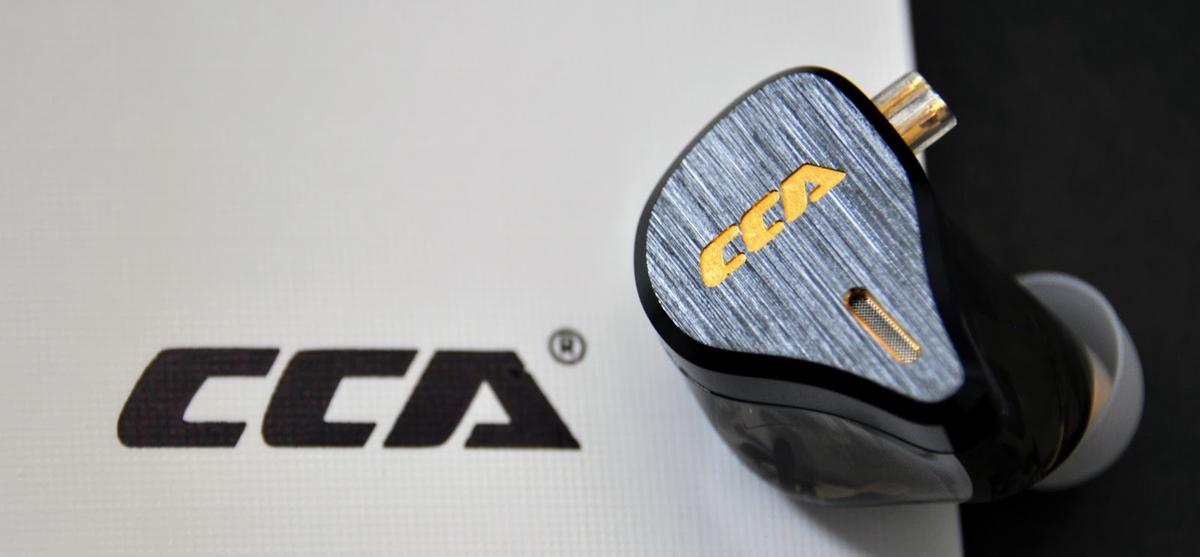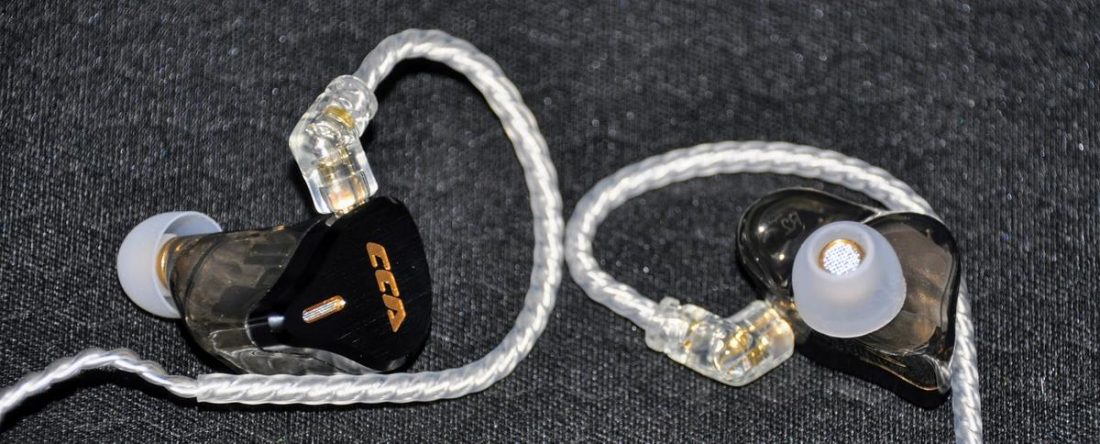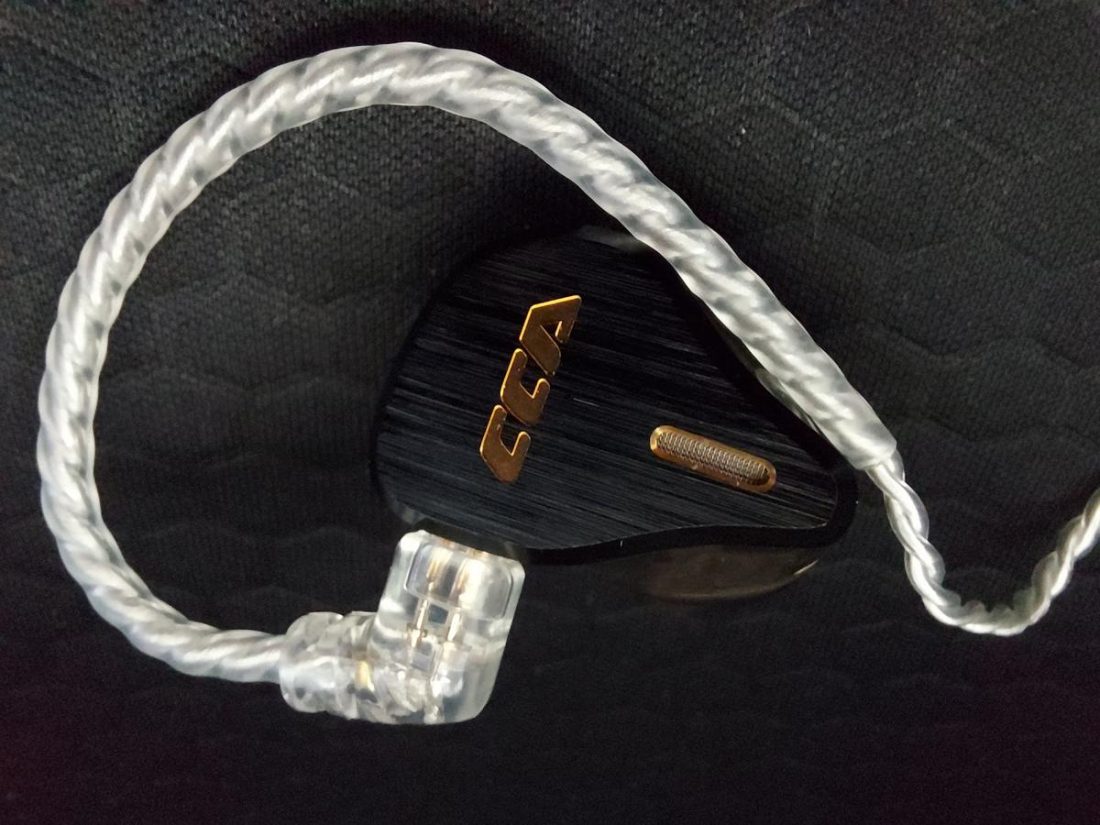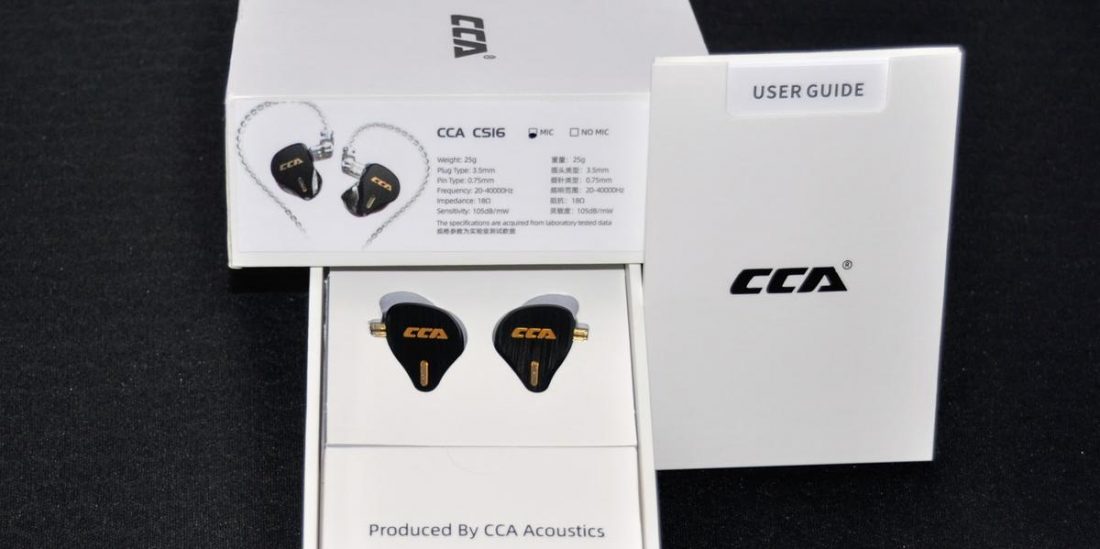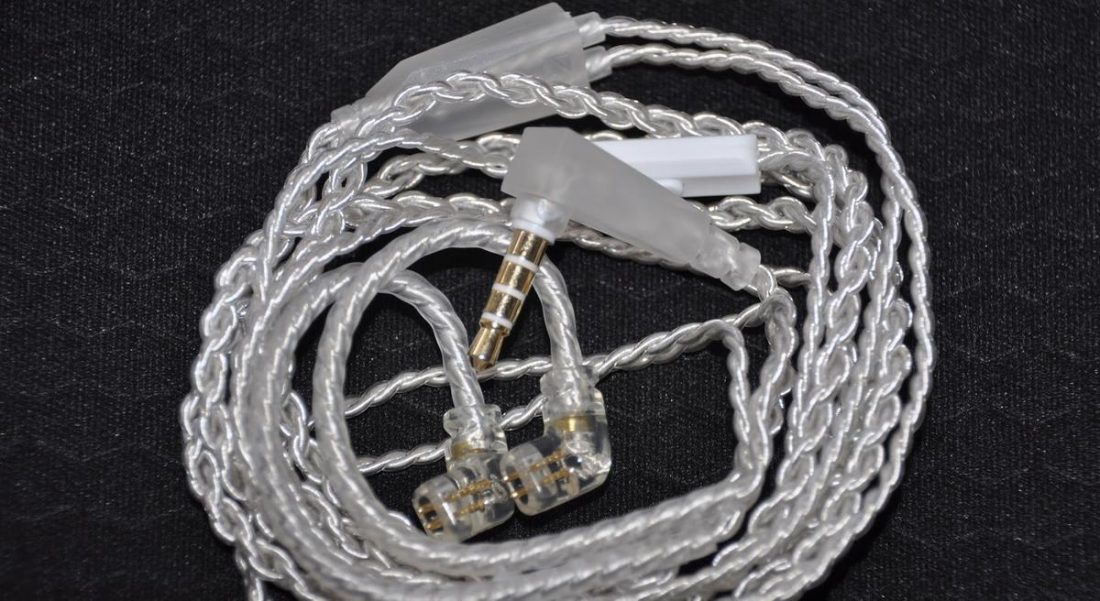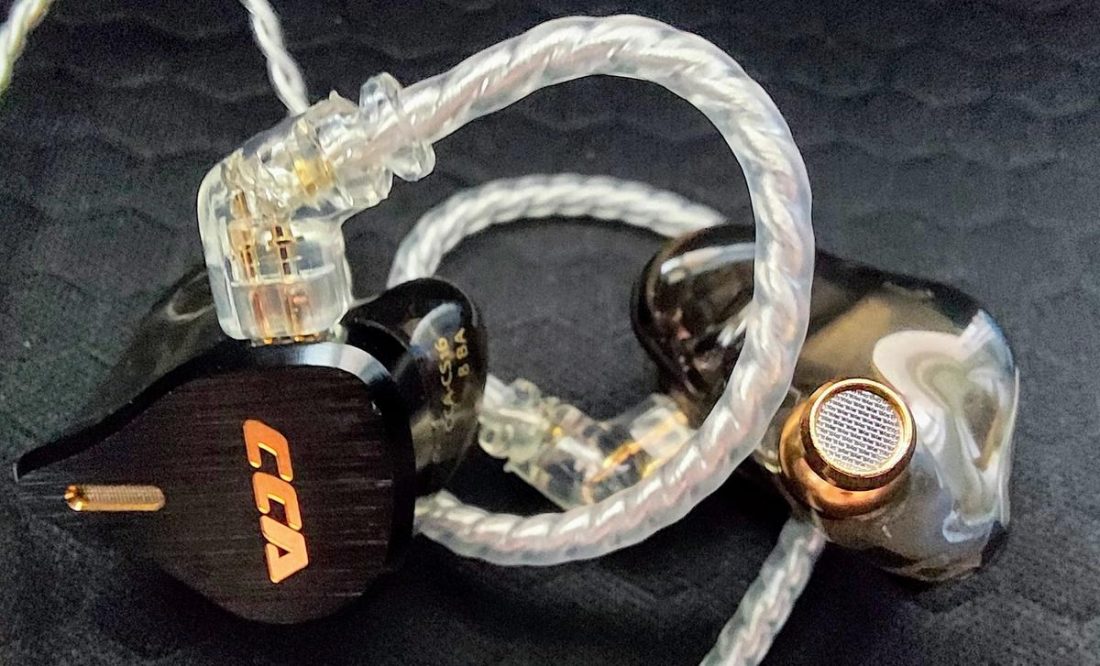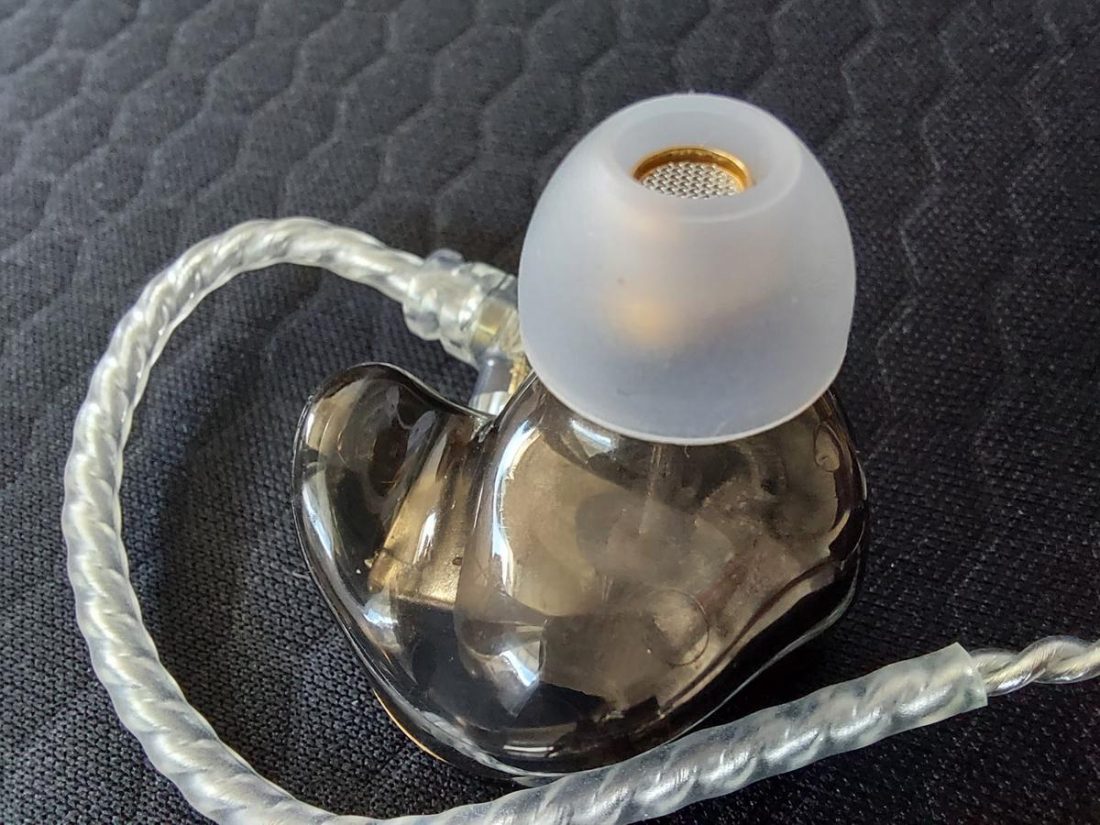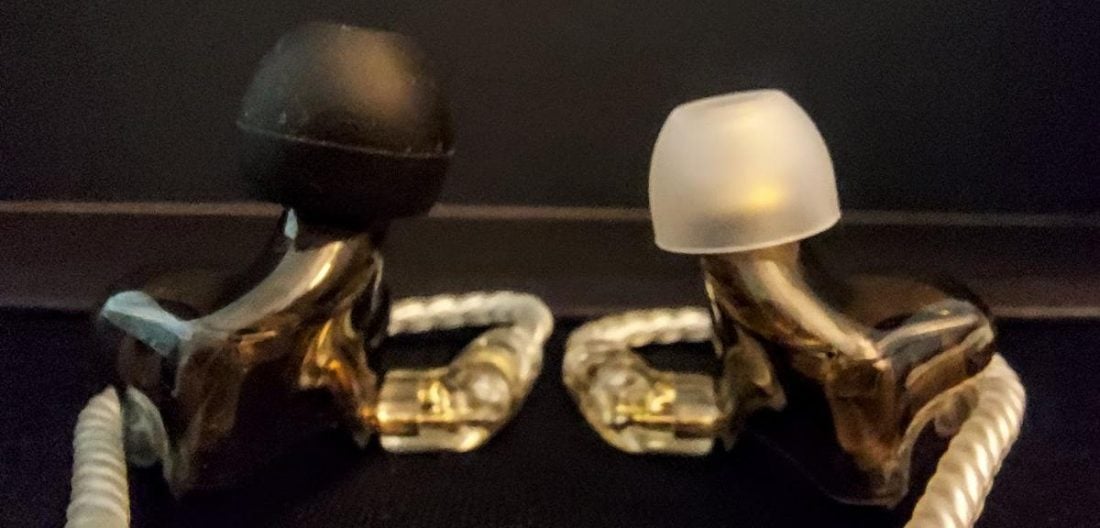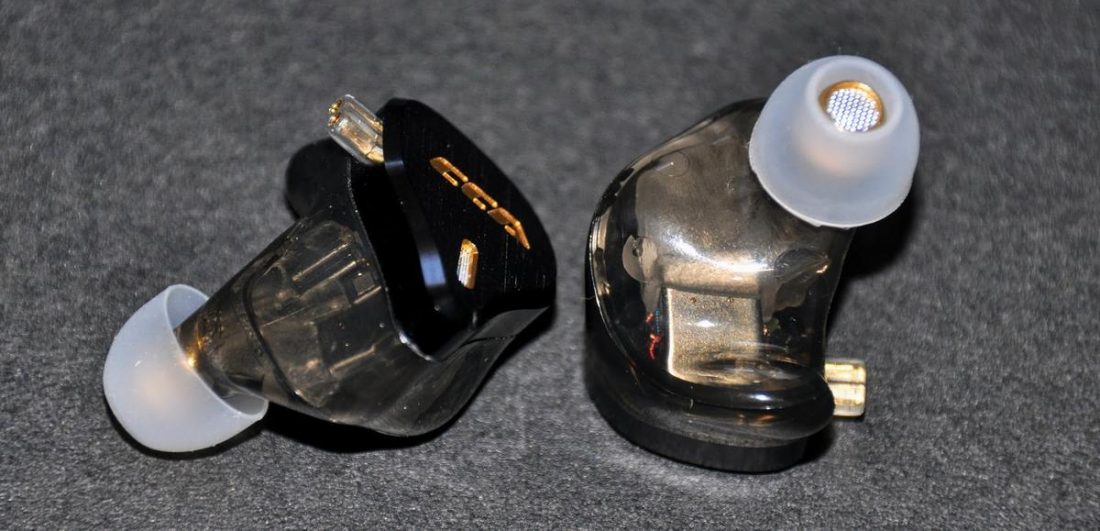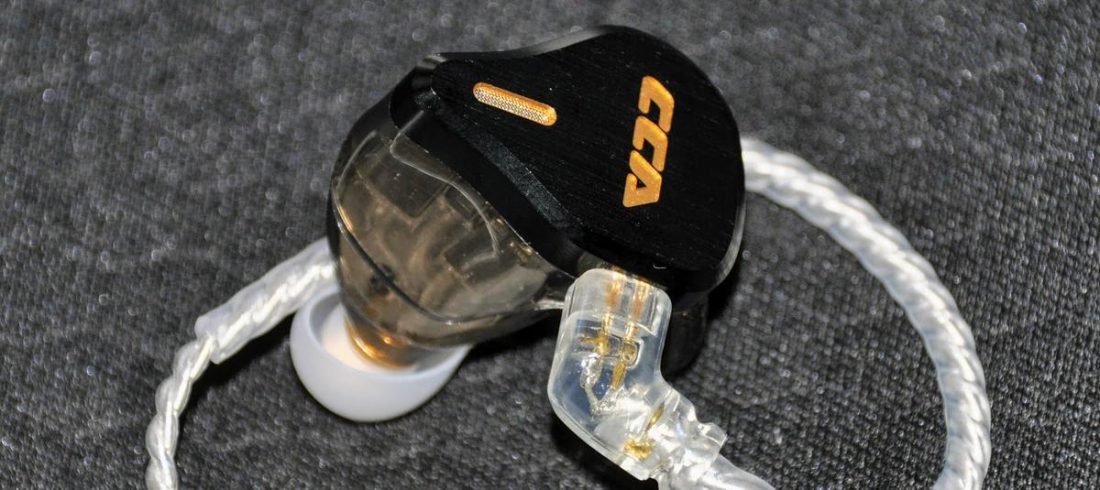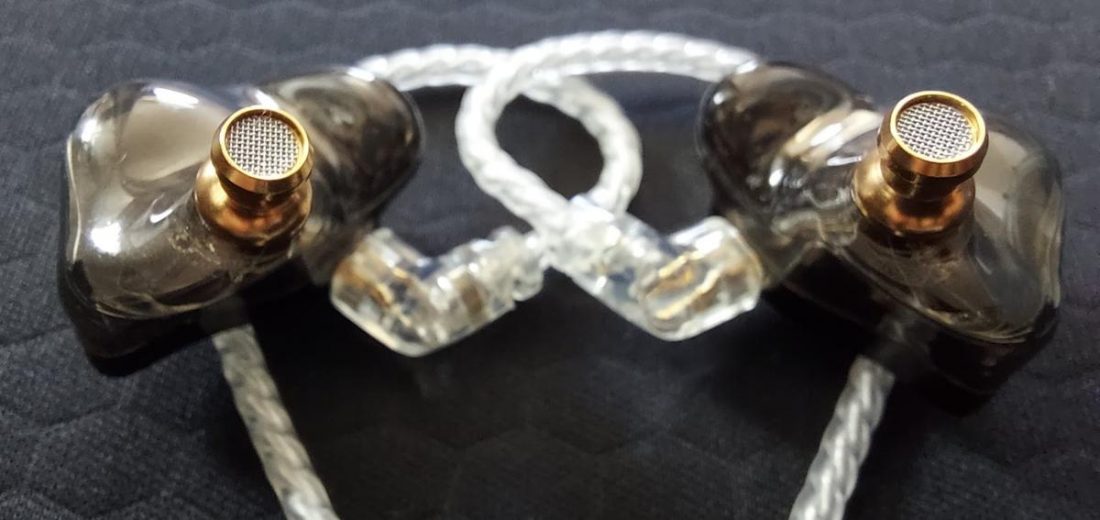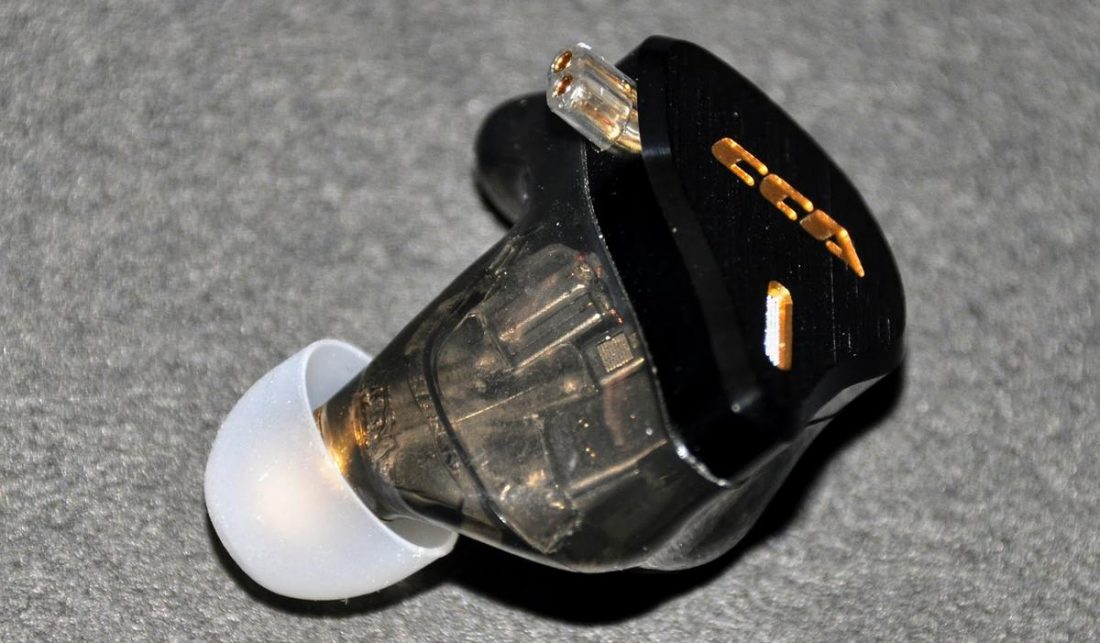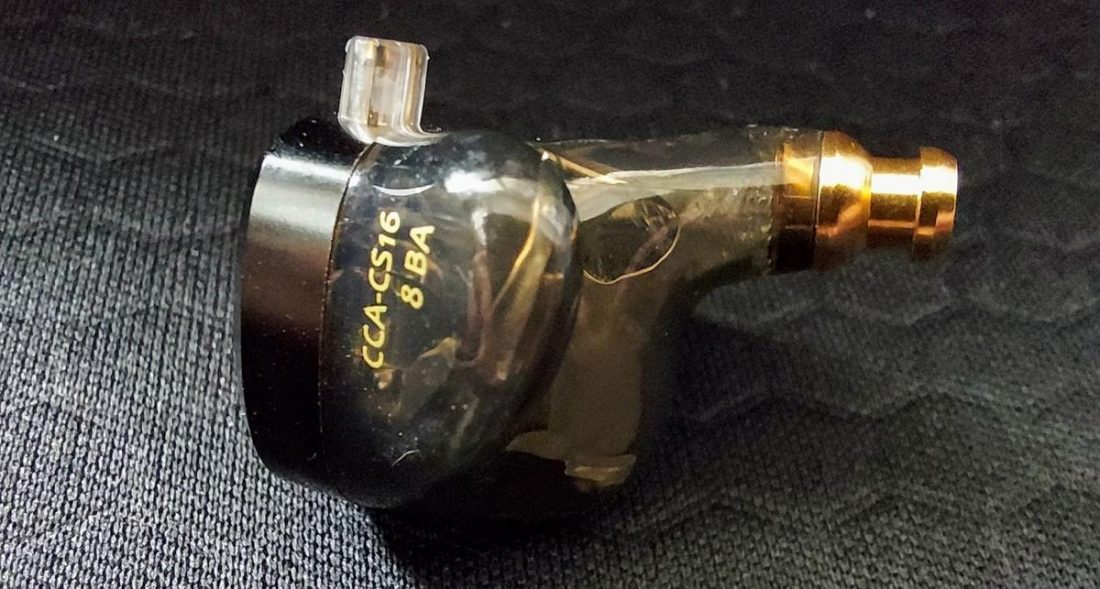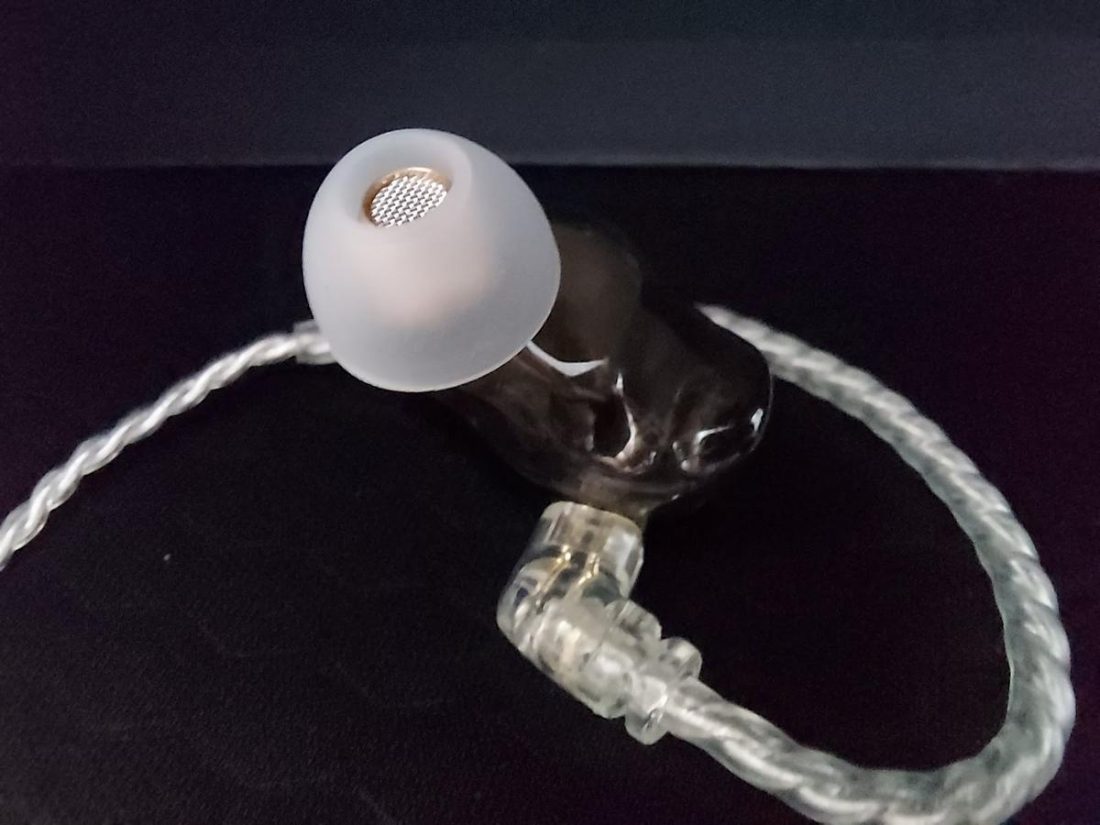Clear Concept Audio (CCA) has produced a range of in-ear monitors (IEMs), offering a wide range of configurations and prices. The CS16 (USD$110) is the newest release and currently the flagship of the group. Despite the confusing and similar nomenclature of CCA’s products, the CS16 is named as such logically, as they have 8 balanced armature (BA) drivers per IEM – amazing! Well, let’s see if all those BAs translate into a sound experience deserving of a flagship title. This alone leads to many questions, including:
How did CCA fit that many in there?! Will they play together well? How will the lack of a dynamic driver affect sound quality and reproduction?
First Impressions
The attractive black aluminum faceplate (silver optional) has an etched bright gold CCA logo. They create an illusion that the CS16 is quite slender and svelte. Once you look behind the face, that illusion is shattered. While not heavy, these are large IEMs in both depth and body size. Certainly, extra interior volume is required to pack so many BAs into the clear resin shells. Their shape conforms to the human ear and are visually interesting to examine. Given my positive experience with CCA C10Pro, I hoped for a significant step up in quality, sound, and performance from the flagship CS16, which costs more than twice as much as the C10Pro. I discovered a challenge to overcome in my previous review of the CCA C10Pro (USD$40.80 currently) – I could not find a proper fit with the supplied ear tips. That was remedied with foam ear tips (not included). I am experiencing a more aggravating issue with the CS16 ear tips and the overall fit. More on that below in the section on Comfort.
Company Overview
Since its establishment in 2004, Shenzhen China-based CCA Innovation Technology Limited has focused on bringing innovative products to the global market in the field of consumer electronics. CCA emphasizes that quality has always been one of their key focus areas — from design, to development, to thorough testing for functionality and reliability prior to release. Although not formally acknowledged, it appears that CCA is a sister brand for IEM mega-company KZ. CCA offers similar IEMs to KZ models, sharing components, technology, design, packaging, ear tips, cable, etc. While specific differences vary by model, they are targeted at the same budget IEM market.
Technical Specifications
Transducer Driver: 8 double row array Balanced Armatures (BA) in-ear monitors; 22955 BA for low frequency, 29689 BA for middle frequency, 31736 BA for middle and high frequency, 30017 BA for high frequency Impedance: 18 Ohms Sensitivity: 105db Frequency range: 20 Hz – 40 kHz Style: In-ear, with earhook cable Connector: 0.75mm 2 Pin Plug Type: 3.5mm L-shape gold-plated plug Cable length and type: 1.25m (4.1 ft) hand-woven high-purity silver-plated cable (4 x 25 cores), HD microphone optional
Packaging
Almost identical to the C10 Pro, minimal packaging is greatly appreciated from a consumable/recyclable standpoint. The only plastic used is a light thin plastic film securing the box. Theoretically, this also means that the consumer is payi.ng less for the wrapping and more for the product. Others may not share this optimistic perspective and expect that a brand’s top-of-the-line product ought to have multiple distinguishing attributes from its siblings. This is not the case for the CS16. I expected premium included accessories, including a storage/carrying pouch or case and far better ear tips (much more on this to come).
In the box
2 CCA CS16 IEMs 1 hand-woven high-purity silver-plated detachable cable (1.25m long, 4 x 25 cores), HD microphone optional 4 pairs of cloudy white/clear silicone ear tips (Small (1), Medium (2), Large (1)) Printed instruction and information pamphlet that provides basic and minimal information
Cable
The cable appears to be virtually the same as the one provided with the C10 Pro: a flexible, lightweight standard 100-core silver-plated cable that performs well. The sturdy translucent plastic wishbone protective splitter is slightly different, as well as the plastic housing for the plug. There is no sliding cinch. It has a 90° earplug design and a 3.5mm gold plated plug. The built-in microphone employs one-button push operation and feels solid with strong positive actuation. Interestingly, the plug length extending beyond the housing is slightly longer than the one on the cable for the C10 Pro, making it possible to connect to mobile devices in a protective case more easily. The cable transmits no microphonics. The ear hooks have a plastic sleeve to help retain shape and for a flexible fit around the ear. They are secure and comfortable, depending on which ear tips you use (more on that below).
Design
The CS16 combines aviation-grade aluminum alloy with a translucent resin shell, allowing you a window into the internal drivers and wiring. The parts fit together beautifully with no noticeable seams. Given their bulk, they protrude out from the ears enough to be noticeable. The nozzles are gold colored and appear to be attached well to the body. The nozzles are appropriately long and proportionate to the body. Ear tips easily apply and remove, and remain secure once fitted.
Comfort
It is here that I have some major gripes with CCA’s choices. First, I believe it’s necessary to digress a moment to make a point for the benefit of potential buyers who do not yet have much experience with earphones or IEMs. There are three main IEM elements: Addressing the above three items: At Headphonesty, we continually emphasize (ad nauseum) how critical it is for a listener to find a good fit, and most importantly, a proper seal in the ear canal. No seal = failure. This is not the case for on or over-ear headphones, which are far more forgiving of a less than perfect fit. There is simply not a way to do a fair evaluation of, let alone enjoy, a pair of IEMs without the above. I am unable to achieve anything close to a proper seal with the included silicone ear tips (4 pairs of varied sizes). Through all of them, I can feel the nozzle scraping my ear canal with any press on the body inward trying to achieve a seal. This simply should not happen. The reason for this is evident looking at the picture below. When correctly attached to the nozzle, the ear tips are unusually shallow and hardly extend into the ear canal farther than the nozzle tip. This is not normal nor successful. To compensate for such a large body, I presume it was deemed necessary to make the ear tips short and shallow so that the IEMs will sit as flush into the ears as possible. For me, it occasionally takes experimentation with a variety of ear tips (size, shape, and material) to achieve a good seal. In this case, after an extensive in-home search, I am using an alternate from a Thieaudio IEM, pictured below on the CCA CS16. This transforms the IEM from an immediate product return and negative review into a flagship worth investing time with. This leads to another unintended and unpleasant consequence. The new tips, which are significantly taller (see picture below), produce vastly improved sound. This comes at a cost to fit and comfort. The taller tips cause the CS16s to protrude even farther out, which in turn leads the ear hooks and cable away from the head as well. This in turn applies undue pressure on the upper ear while not laying flat behind the ear as originally intended. The cord’s comfort is acceptable. The ear hooks hold well and conform around the ear without exerting any bothersome pressure, assuming that the IEMs are placed well in the ear canals as far as is comfortable for the listener so that the body of the IEMs do not overly protrude from the profile of the head.
Internals
The CS16 IEMs are armed with 8 balanced armatures per IEM. Each dual-row driver handles a specific area of the frequency spectrum. There are two each of the following:
CCA CS16 Sound
I’m conflicted on this affirmation. To be in tune with what I am hearing, I must make some revisions. Innovative configuration and inside structure – probably. Reference-level sound quality? No. To be “reference quality,” I expect a fairly full, flat, and uncolored frequency response. That is not what my ears are hearing. Comparing them to traditional (dynamic) drivers, I can agree that the CS16s do present a wide dynamic range at only mid-high frequencies, with detailed sound features. For evaluation, I listened to a great variety of music from numerous sources including:
Sony DVP-S7000 CD Player LG V20 phone with quad DAC (has a headphone jack) Samsung A71 (in 2020-21, still has a headphone jack!) FiiO A3 Samsung Chromebook
With a high sensitivity of 105db and a low impedance of 18 ohms, these IEMs are easy to drive with virtually any source. That said, I found them to sound better with amplification via a quality AMP/DAC. If you have such a device, or a source that allows you to adjust the sound profile, you may find significant improvements with your own preferred tuning. The CS16 IEMs are best suited for music that emphasizes midrange and treble, natural instrumental tones, and non-aggressive music. This includes acapella and performances with vocal emphasis, acoustic recordings, smooth jazz, country, folk, and some less dynamic orchestral/classical music. I do not recommend them for music that emphasizes heavy bass or fast attack type of sounds and transitions. These are IEMs that listeners who appreciate a great deal of presence and vocal/midrange forward sound will gravitate to — high dynamics, detail, and clarity. Mid-high frequencies are also fairly smooth in transitions. Channel separation is good and produces an average soundstage with good spaciousness. While imaging is adequate, I would not describe it as a strength.
Bass
CCA claims fast energetic low frequency, with clear texture and low distortion from the double-row array BA. I find it challenging to support that claim, as there is a paradox in the bass response. Bass is natural, quick resolving, and acceptable when listening to music that primarily presents natural bass and lower mid-range. As I do not have insight into CCA’s tuning beyond their marketing descriptions, or have an accurate frequency graph on hand, it is difficult to tell with any precision where the limits are. Listening to bass test tracks, the bass seems reasonably represented and controlled. In the context of full spectrum music, it sounds as if the CS16s are often stressed by sub-bass frequencies. This results in significant distortion and a potentially garbled mess. As a result, the midrange becomes muddied and somewhat unstable as well. This effect is unacceptable for an IEM at this price point. Lovers of music genres where low frequencies are prominent (EDM, techno, trap, club dance, heavy metal, etc.), the CS16s are not for you. Sub-bass seems truly out of reach. When pressed to perform gymnastics in low frequencies, the CS16s trip and clumsily cascade off the mat. Composed-to-chaotic happens fast. There is obvious unpleasant unintended distortion, and far too much of it as they fail to keep up. Using a FiiO A3 amplifier, the bass boost option on the FiiO does little to make up for the deficiency. Understanding that BAs do not typically produce prodigious bass, that deficit can be compensated for by engineering prowess, careful tuning, and shaping of the IEM body cavity to maximize the perception of bass.
Midrange
The CS16 are most competent and confident in the midrange and upper frequencies, highly prominent and forward depending on the source. I find the mids to be impressively differentiated, meaning that they are easy to distinguish between vocals, varied instrumentation, and nuances in emphasis or volume. The result at times is blended beautifully and these IEMs shine. Listening to Enya’s recording And Winter Came…, there are fantastic moments of lucidity. Sadly, there are also confusing moments of odd harmonic resonances that the CS16 do not seem to like at all. Listening to Kealiʻi Reichel’s recording Keʻalaokamaile, the clarity and presence of male and female voices are outstanding — smooth and lifelike. Guitars and ʻukulele sound accurate and lively. With handmade Hawaiian drums and the quality of the recording, the bass is well textured and present, likely due in part to all the space in the recording. This is a rare exception for the CS16’s bass performance. Greg Ellis’ Kala Rupa and Diana Krall’s Live in Paris are equally impressive presented by the CS16.
Treble
CCA promises that the CS16 will demonstrate extended and flexible highs. I will agree that they generally manage that, with clean treble that results in clear, crisp, detailed reproduction. The CS16 may become fatiguing for some listeners depending on the genre of music. I find transitions to be smooth between midrange and treble. Depending on the recording and source, the treble in addition to strong midrange will overpower any lower frequencies, resulting in what I would describe as loud and forward without much body and low end to balance and fill out the sound profile. Joe Satriani’s Surfing with the Alien, with many fast and complex recordings, shines through the CS16, handling mid-high frequencies transitions with grace and precision. Once again, they would be even better with proportionately adequate bass.
Microphone performance
The CS16 version I have for testing has a microphone with a one-button/function control. The button has positive actuation and is difficult to activate by accident. While testing with both mobile phones and a computer using video chat, both receiving and transmitting clarity and sensitivity are excellent.
Where to Buy
Conclusion
Are the CS16s spoiled by excess after all? In their current form, possibly so. Embodying so many drivers, regardless of the space saving dual array BAs, creates an IEM of excess size (and potentially cost). If CCA procured these drivers from a well-known industry supplier, there is no way that the retail cost of the CS16 could be this low. These drivers are most likely created by CCA, and seem to be quite good. The challenge is that setting all the crossovers properly and ensuring that the sound blends well is a significant challenge with so many diverse sources. While the engineering is quite a feat, the tuning needs work. For a flagship product, the CS16 lack in many areas, some of which may not be important to you. I will appreciate seeing distinguished and improved inclusions: an upgraded cable, ear tips, and a carrying pouch or case. While not expensive upgrades, they will improve a buyer’s perception of value in their purchase and improve the product’s performance. As prominently noted in the review, the included tips are a clear mismatch for the CS16s. I humbly suggest to CCA that this be remedied immediately to improve new customer experience. With its current dimensions, this may not be easy to solve, yet will drastically affect results. There really is excellent sound to be found here with some work and proper music selection. Had the fit been better and the CS16 come better equipped, they would have likely earned a 3.5 star rating from me. Given the challenges I experienced, I deducted one full star. Your results may vary, and I’d love to hear your observations and thoughts.
